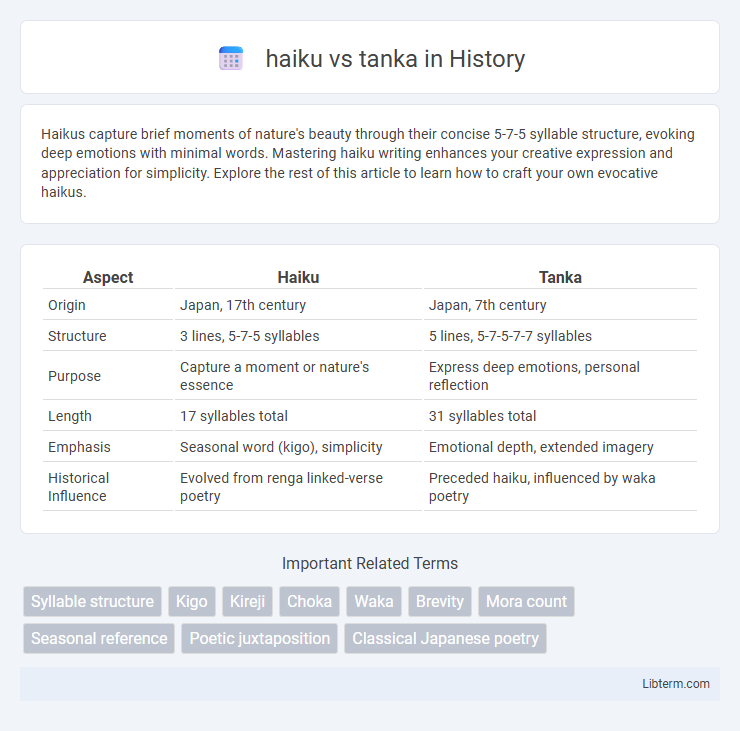Haikus capture brief moments of nature's beauty through their concise 5-7-5 syllable structure, evoking deep emotions with minimal words. Mastering haiku writing enhances your creative expression and appreciation for simplicity. Explore the rest of this article to learn how to craft your own evocative haikus.
Table of Comparison
| Aspect | Haiku | Tanka |
|---|---|---|
| Origin | Japan, 17th century | Japan, 7th century |
| Structure | 3 lines, 5-7-5 syllables | 5 lines, 5-7-5-7-7 syllables |
| Purpose | Capture a moment or nature's essence | Express deep emotions, personal reflection |
| Length | 17 syllables total | 31 syllables total |
| Emphasis | Seasonal word (kigo), simplicity | Emotional depth, extended imagery |
| Historical Influence | Evolved from renga linked-verse poetry | Preceded haiku, influenced by waka poetry |
Introduction to Haiku and Tanka
Haiku is a traditional Japanese poetic form consisting of three lines with a 5-7-5 syllable pattern, often capturing moments in nature or seasonal themes. Tanka extends this structure to five lines with a 5-7-5-7-7 syllable count, allowing for a deeper emotional expression and narrative. Both forms emphasize simplicity and depth, but tanka provides more room for personal reflection and imagery.
Historical Origins and Evolution
Haiku originated in 17th-century Japan as a distilled form of the earlier renga poetry, emphasizing a 5-7-5 syllable structure that captures fleeting moments of nature and emotion. Tanka, with roots dating back over 1,300 years to the Heian period, consists of five lines following a 5-7-5-7-7 syllabic pattern and traditionally explored more complex themes of love and personal reflection. Over centuries, haiku evolved into a minimalist poetic form internationally recognized for its brevity and depth, while tanka maintained its lyrical and expressive qualities, influencing modern Japanese literature significantly.
Structural Differences: Syllable Count and Format
Haiku consists of three lines with a syllable pattern of 5-7-5, totaling 17 syllables, while tanka extends to five lines with a 5-7-5-7-7 syllable structure, amounting to 31 syllables. Haiku traditionally captures a moment or nature observation, whereas tanka allows for a more expressive and elaborate reflection. The difference in syllable count and line number fundamentally distinguishes the concise minimalism of haiku from the expanded narrative capacity of tanka.
Themes and Subject Matter
Haiku traditionally emphasize nature, seasons, and fleeting moments, capturing a single, vivid image that evokes deep emotion and reflection. Tanka expands on haiku's themes by including personal emotions, love, relationships, and human experiences alongside natural elements, allowing a broader emotional and thematic range. Both forms utilize symbolic imagery, but tanka's additional two lines create a narrative or emotional context beyond haiku's concise expression.
Use of Imagery and Language
Haiku utilizes concise, vivid imagery drawn from nature to evoke a moment's essence in just 17 syllables, emphasizing simplicity and seasonal references. Tanka expands this framework into 31 syllables, allowing richer emotional depth and personal reflection alongside natural imagery. Both forms employ metaphor and symbolic language, but tanka's extended structure enables a more complex interplay between external scenes and internal feelings.
Emotional Expression and Tone
Haiku captures fleeting emotions with brevity, often evoking a moment of natural beauty or a sudden insight through concise imagery. Tanka allows for deeper emotional expression by combining the haiku's 5-7-5 structure with an additional two lines of 7-7 syllables, creating a more expansive and reflective tone. This extension enables tanka to explore complex human feelings, nostalgia, and personal introspection beyond the haiku's minimalistic and immediate emotional impact.
Seasonal References: Kigo in Haiku vs Tanka
Haiku traditionally incorporates a kigo, a specific seasonal word that anchors the poem in a particular time of year, reflecting nature's transient beauty within its 17-syllable, three-line structure. Tanka, with its longer 31-syllable, five-line form, often employs seasonal imagery more flexibly, allowing for multiple kigo or a broader exploration of seasonal moods and human emotions intertwined with nature. While haiku emphasizes a sharp, singular seasonal moment, tanka provides a richer, more layered seasonal context through its extended verses.
Modern Adaptations and Variations
Modern adaptations of haiku and tanka poetry emphasize brevity and emotional depth, often blending traditional structures with contemporary themes. Haiku maintains its iconic 5-7-5 syllable pattern but frequently incorporates free verse and visual elements, expanding its expressive potential. Tanka adaptations explore more flexible syllabic patterns while preserving its 5-line form, highlighting personal reflection and narrative complexity in a modern context.
Popular Examples in Literature
Haiku, characterized by a 5-7-5 syllable structure, features popular works like Matsuo Basho's "An old silent pond," which captures nature's fleeting moments with simplicity. Tanka, consisting of five lines with a 5-7-5-7-7 syllable pattern, appears prominently in the Man'yoshu anthology, showcasing rich emotional expression and detailed imagery, as in Ono no Komachi's poetic love laments. Both forms maintain a significant presence in Japanese literature, with haiku emphasizing brevity and tanka exploring elaborated emotional depth.
Choosing Between Haiku and Tanka
Choosing between haiku and tanka depends on the desired expression and length; haiku, with a strict 5-7-5 syllable structure, captures a concise snapshot of nature or emotion in three lines. Tanka, extending to five lines with a 5-7-5-7-7 syllable pattern, allows for more elaborate emotional depth and narrative detail. Writers seeking brevity opt for haiku, while those wanting a richer, more nuanced poem select tanka for its expanded form.
haiku Infographic

 libterm.com
libterm.com